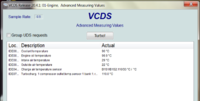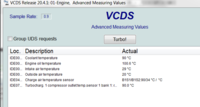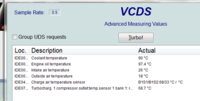Assume so.Minus ambient it's 22psi
You are using an out of date browser. It may not display this or other websites correctly.
You should upgrade or use an alternative browser.
You should upgrade or use an alternative browser.
Definitely check the pre charge cooler temp with an independent/stand alone sensor. I know you swapped both sensors with no effect but it could still be a fault in the wiring that changes the signal.
As said above and on previous pages the temp drop across the charge cooler just isn't realistic.
As said above and on previous pages the temp drop across the charge cooler just isn't realistic.
Righty, just had chance to leave VCDS on whilst out and about.
Dual Carriageway - probably as close a load to your dyno run we'll get;

In town;

Cool down;

The charge temp value does give both sides. Also see compressor outlet is same as hot side charge cooler temp.
I'm very surprised at the turbo compressor outlet temps, and the temp drop across the charge cooler. The charge cooler is taking such a lot of heat out of the air. I didn't expect that!
Your figures don't look that out of the way now..... Mines a 2017 204 DSG LWB PV
Let me know if you want any more. I wonder if we can see fuel flow in there somewhere.
Dual Carriageway - probably as close a load to your dyno run we'll get;

In town;

Cool down;

The charge temp value does give both sides. Also see compressor outlet is same as hot side charge cooler temp.
I'm very surprised at the turbo compressor outlet temps, and the temp drop across the charge cooler. The charge cooler is taking such a lot of heat out of the air. I didn't expect that!
Your figures don't look that out of the way now..... Mines a 2017 204 DSG LWB PV
Let me know if you want any more. I wonder if we can see fuel flow in there somewhere.
Hi, little experience based information from me. I have similar vw t6 204 ps dsg and i had it remapped, before the remap they made a dyno run on original condition and the result was similar 137 kw @ crank, after remap of course 186 kw@ crank and huge improvement, but the point is that my mechanic said that the possible weak power result on oem map is from VW dieselgate and mandatory software update to meet the wanted emissions wich has as a sideeffect a power loss on our engines. So do not worry and just remap it .
That's great readings matey thank you for all your effort, will pass this on, it may be an abnormal thing after all and all seems ok. Was just a surprise from my guy and a few others. Does raise the question of ordering a 204 and not getting a 204.. ha ha haRighty, just had chance to leave VCDS on whilst out and about.
Dual Carriageway - probably as close a load to your dyno run we'll get;
View attachment 76193
In town;
View attachment 76194
Cool down;
View attachment 76195
The charge temp value does give both sides. Also see compressor outlet is same as hot side charge cooler temp.
I'm very surprised at the turbo compressor outlet temps, and the temp drop across the charge cooler. The charge cooler is taking such a lot of heat out of the air. I didn't expect that!
Your figures don't look that out of the way now..... Mines a 2017 204 DSG LWB PV
Let me know if you want any more. I wonder if we can see fuel flow in there somewhere.
No adverse to having it mapped? How's your fuel consumping? I typically get 36 but often more. Thank you for this . Good adviseHi, little experience based information from me. I have similar vw t6 204 ps dsg and i had it remapped, before the remap they made a dyno run on original condition and the result was similar 137 kw @ crank, after remap of course 186 kw@ crank and huge improvement, but the point is that my mechanic said that the possible weak power result on oem map is from VW dieselgate and mandatory software update to meet the wanted emissions wich has as a sideeffect a power loss on our engines. So do not worry and just remap it .
Is there a comparison of turbo pressures somewhere? I seem to remember a figure of 20 something psi after correction.. seems very high.
I thought this a lot too, have spoke to a few people now and looks like this could be a normal boost. Yet to confirm this , but I have had boost readings from one other van and it is running about the same give or take a psi.Is there a comparison of turbo pressures somewhere? I seem to remember a figure of 20 something psi after correction.. seems very high.
I really didn't expect it to be that high.
Right all. I'm booked in to VW Inverness Thursday morning to go on Thier diags machine. I'm asking for running diags on the dog, anything else you have experianced or can think of to get my hours money worth out of them please shout up. I know thee were some dog regen fails and no fault codes so don't expect anything differnet. But anything I can direct them to tell me.
Further Update on the Thread,
I have been to the VW dealership to partly do as some member suggested and partly rule out any doubts.
Hooked up for a diagnosis on the vans sensors temps boost MAF reading etc etc.
and all are testing within the guide lines of the VW specialst hand book. Temps were after a run on the road and checked and not at maximum load as my guy did on the roling road. which would like;y be the differneces seen.
One fault that was there that was not readable through VCS was a fault in the EGR Valve sticking, it is a Known Intermitent problem from VW and one that they have not tried to fix and will not fix. £1200 to replace and I was advised to leave it be as it may never turn on the engine warning light. Loss of power wise, as expected from a local dealer they simply took it out for a drive and told me it was performing as normal. No rolling road test etc.
Basically if your Warning lght comes up or it is part of a potential OTHER ISSUE then VW will suggest a flush through to clena it, they WILL NOT WARRENT it until a warnig light appears. But the good side of this is they will Do this up to 5 years from the initial purchase of the vehicle under warrenty. This was from the Tech!
Basically they pull off some hoses attach a water hose, Turn on the engine then turn on the watter hose and flush it through with water.
Hope this helps someone some where, doesn't explain the power differnce.....
I have been to the VW dealership to partly do as some member suggested and partly rule out any doubts.
Hooked up for a diagnosis on the vans sensors temps boost MAF reading etc etc.
and all are testing within the guide lines of the VW specialst hand book. Temps were after a run on the road and checked and not at maximum load as my guy did on the roling road. which would like;y be the differneces seen.
One fault that was there that was not readable through VCS was a fault in the EGR Valve sticking, it is a Known Intermitent problem from VW and one that they have not tried to fix and will not fix. £1200 to replace and I was advised to leave it be as it may never turn on the engine warning light. Loss of power wise, as expected from a local dealer they simply took it out for a drive and told me it was performing as normal. No rolling road test etc.
Basically if your Warning lght comes up or it is part of a potential OTHER ISSUE then VW will suggest a flush through to clena it, they WILL NOT WARRENT it until a warnig light appears. But the good side of this is they will Do this up to 5 years from the initial purchase of the vehicle under warrenty. This was from the Tech!
Basically they pull off some hoses attach a water hose, Turn on the engine then turn on the watter hose and flush it through with water.
Hope this helps someone some where, doesn't explain the power differnce.....
What!?!Basically they pull off some hoses attach a water hose, Turn on the engine then turn on the watter hose and flush it through with water.
Don't try this at home, kids!!!Basically they pull off some hoses attach a water hose, Turn on the engine then turn on the watter hose and flush it through with water.
An option open to you is to ask an independent garage to give you a quote to remove, clean, check and refit your EGR valve, it would / should be significantly cheaper than £1200 and might help to put your mind at rest. I say this because a sticking EGR valve is likely to be sticking because of carbon (soot) build up. an EGR valve that doesn't fully close allows exhaust gas in to the inlet manifold all of the time, even when you want to accelerate, so reducing power. If you get a quote and it's too expensive, you don't have to do it. I am not aware of any proven way to properly clean an EGR valve without removing it, despite what some may say. I think I recall there are members of this forum who have cleaned their own EGR valves but this may be more than you are comfortable doing.One fault that was there that was not readable through VCS was a fault in the EGR Valve sticking, it is a Known Intermitent problem from VW and one that they have not tried to fix and will not fix. £1200 to replace and I was advised to leave it be as it may never turn on the engine warning light.
Last edited:
Just done a search.....the pictures will show you just how much crud builds up. Interestingly one post was quoted £700 for a new EGR valve, this year.

 www.t6forum.com
www.t6forum.com
Edit, I see you've contributed to that thread!

EGR valve fault
Hello all My engine light has come on again on my T6 . It has again shown up as this fault - EGR- on diagnostic tool. Looks like I’ll have to purchase one or is there another fix that anyone knows of? If not are they easy Enough to fit cheers Glenn
Edit, I see you've contributed to that thread!
Last edited:
If I’m reading this right VW will only act on a dash warning light and not a stored fault code....so does the panel think that VW could have a diesel gate scenario going on ...that could program the system to record a fault but never display it as a warning light...or is that even possible....WOW ...it makes you wander they could f**k my engine and get away with itSo VW are admitting that there is a common intermittent fault with the Euro 6 emission control system that they will bodge until 5 years are up then it’s your problem.
Hope you have that in an email.y
Similar threads
- Replies
- 7
- Views
- 3K
- Replies
- 10
- Views
- 3K
- Replies
- 169
- Views
- 40K
- Replies
- 29
- Views
- 52K
